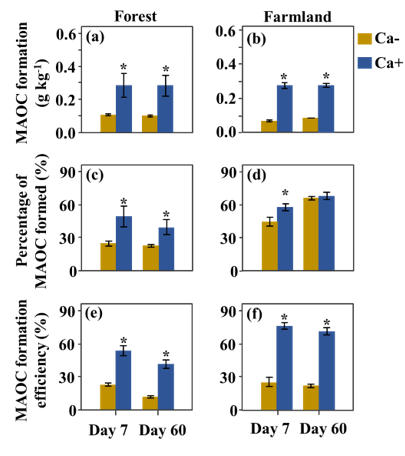Wollastonite Boosts Stable Soil Carbon Formation through Distinct Pathways in Forest and Farmland Soils
Researchers from the Institute of Applied Ecology, Chinese Academy of Sciences (CAS), have unveiled how the addition of powdered wollastonite, a calcium silicate mineral, significantly enhances the formation of stable mineral-associated organic carbon (MAOC) in different soil types. The findings were recently published in Soil Biology and Biochemistry under the title “Similar mineral-associated organic carbon formation but distinct efficiencies by powdered wollastonite addition between two soils.” The study was led by Dr. ZHANG Weidong, a senior researcher at the institute.
Enhanced Rock Weathering, a carbon removal strategy that involves applying silicate minerals such as wollastonite to soils, has gained global attention due to its dual potential to capture atmospheric CO2 and improve soil quality. Beyond its geochemical benefits, silicate addition can influence soil microbial activity and the stabilization of soil organic carbon (SOC). Among SOC fractions, MAOC is especially critical because it binds tightly to minerals, allowing carbon to persist in soils for decades or even centuries. However, how wollastonite addition affects MAOC formation and whether soil type modulates this effect has remained unclear.
To address this question, the team conducted a short-term incubation experiment using soils from a Cunninghamia lanceolata (Chinese fir) plantation and a maize farmland in Huitong County, Hunan Province. Both soils were amended with 5 % (w/w) wollastonite (CaSiO3) and supplied with ¹³C-labeled glucose to trace carbon flow. The researchers further used 18O isotope labeling to measure microbial carbon use efficiency (CUE) and biomass turnover.
The study showed that wollastonite addition markedly increased ¹³C-MAOC by approximately 170 % in forest soil and 250 % in farmland soil, indicating a strong promotion of stable carbon formation in both systems. However, the underlying mechanisms differed, according to the researchers. In forest soil, MAOC accumulation was mainly driven by a rise in pH and increased available phosphorus, which together enhanced microbial CUE by about 130 %. In farmland soil, CUE remained statistically unchanged, but microbes redirected more carbon toward anabolic synthesis rather than respiration, resulting in a notably higher MAOC formation efficiency compared to the forest soil.
These findings provide a systematic evidence that wollastonite addition stimulates MAOC formation through distinct biochemical and mineral pathways in divergent soil types. The study emphasizes that microbial metabolism and mineral–organic associations jointly regulate soil carbon stabilization. By demonstrating how these processes differ between forest and agricultural systems, the research offers critical knowledge that could guide soil management strategies to enhance carbon sequestration efforts for climate change mitigation.

Figure 1. Effects of wollastonite (CaSiO3) addition on soil carbon fractions in forest and farmland soils. Wollastonite markedly increased ¹³C-mineral-associated organic carbon (MAOC) in both soils (Image by YAN Yongxue).



